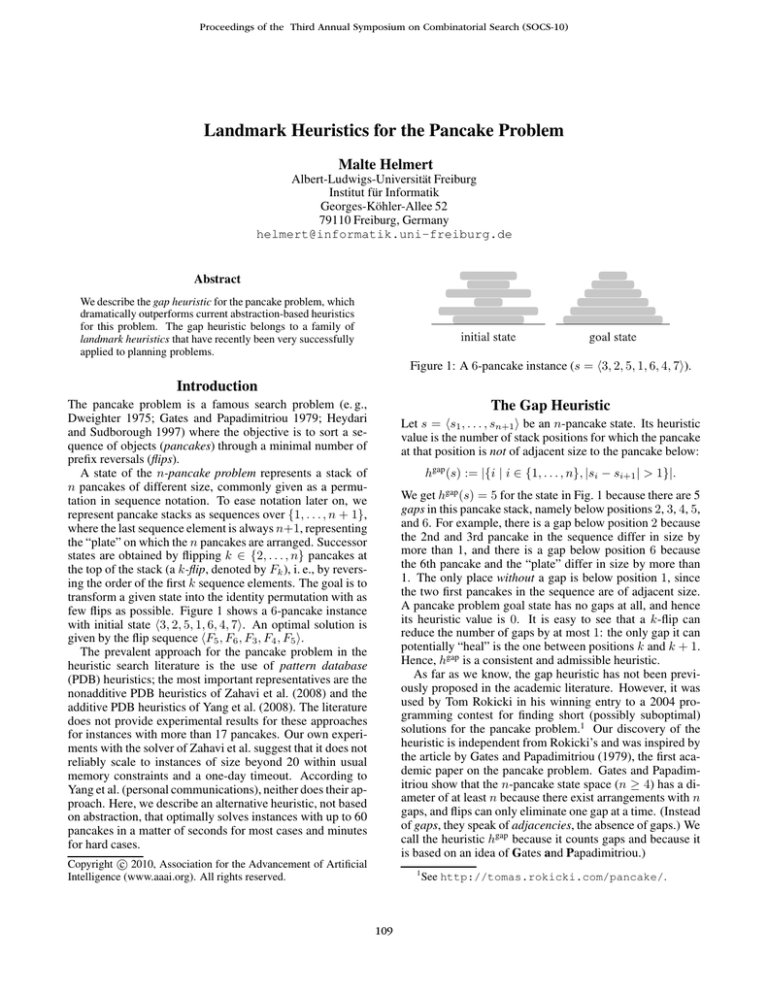
Proceedings of the Third Annual Symposium on Combinatorial Search (SOCS-10)
Landmark Heuristics for the Pancake Problem
Malte Helmert
Albert-Ludwigs-Universität Freiburg
Institut für Informatik
Georges-Köhler-Allee 52
79110 Freiburg, Germany
helmert@informatik.uni-freiburg.de
Abstract
We describe the gap heuristic for the pancake problem, which
dramatically outperforms current abstraction-based heuristics
for this problem. The gap heuristic belongs to a family of
landmark heuristics that have recently been very successfully
applied to planning problems.
Figure 1: A 6-pancake instance (s = h3, 2, 5, 1, 6, 4, 7i).
Introduction
The pancake problem is a famous search problem (e. g.,
Dweighter 1975; Gates and Papadimitriou 1979; Heydari
and Sudborough 1997) where the objective is to sort a sequence of objects (pancakes) through a minimal number of
prefix reversals (flips).
A state of the n-pancake problem represents a stack of
n pancakes of different size, commonly given as a permutation in sequence notation. To ease notation later on, we
represent pancake stacks as sequences over {1, . . . , n + 1},
where the last sequence element is always n+1, representing
the “plate” on which the n pancakes are arranged. Successor
states are obtained by flipping k ∈ {2, . . . , n} pancakes at
the top of the stack (a k-flip, denoted by Fk ), i. e., by reversing the order of the first k sequence elements. The goal is to
transform a given state into the identity permutation with as
few flips as possible. Figure 1 shows a 6-pancake instance
with initial state h3, 2, 5, 1, 6, 4, 7i. An optimal solution is
given by the flip sequence hF5 , F6 , F3 , F4 , F5 i.
The prevalent approach for the pancake problem in the
heuristic search literature is the use of pattern database
(PDB) heuristics; the most important representatives are the
nonadditive PDB heuristics of Zahavi et al. (2008) and the
additive PDB heuristics of Yang et al. (2008). The literature
does not provide experimental results for these approaches
for instances with more than 17 pancakes. Our own experiments with the solver of Zahavi et al. suggest that it does not
reliably scale to instances of size beyond 20 within usual
memory constraints and a one-day timeout. According to
Yang et al. (personal communications), neither does their approach. Here, we describe an alternative heuristic, not based
on abstraction, that optimally solves instances with up to 60
pancakes in a matter of seconds for most cases and minutes
for hard cases.
The Gap Heuristic
Let s = hs1 , . . . , sn+1 i be an n-pancake state. Its heuristic
value is the number of stack positions for which the pancake
at that position is not of adjacent size to the pancake below:
hgap (s) := |{i | i ∈ {1, . . . , n}, |si − si+1 | > 1}|.
We get hgap (s) = 5 for the state in Fig. 1 because there are 5
gaps in this pancake stack, namely below positions 2, 3, 4, 5,
and 6. For example, there is a gap below position 2 because
the 2nd and 3rd pancake in the sequence differ in size by
more than 1, and there is a gap below position 6 because
the 6th pancake and the “plate” differ in size by more than
1. The only place without a gap is below position 1, since
the two first pancakes in the sequence are of adjacent size.
A pancake problem goal state has no gaps at all, and hence
its heuristic value is 0. It is easy to see that a k-flip can
reduce the number of gaps by at most 1: the only gap it can
potentially “heal” is the one between positions k and k + 1.
Hence, hgap is a consistent and admissible heuristic.
As far as we know, the gap heuristic has not been previously proposed in the academic literature. However, it was
used by Tom Rokicki in his winning entry to a 2004 programming contest for finding short (possibly suboptimal)
solutions for the pancake problem.1 Our discovery of the
heuristic is independent from Rokicki’s and was inspired by
the article by Gates and Papadimitriou (1979), the first academic paper on the pancake problem. Gates and Papadimitriou show that the n-pancake state space (n ≥ 4) has a diameter of at least n because there exist arrangements with n
gaps, and flips can only eliminate one gap at a time. (Instead
of gaps, they speak of adjacencies, the absence of gaps.) We
call the heuristic hgap because it counts gaps and because it
is based on an idea of Gates and Papadimitriou.)
c 2010, Association for the Advancement of Artificial
Copyright Intelligence (www.aaai.org). All rights reserved.
1
109
See http://tomas.rokicki.com/pancake/.
n
2
3
4
5
6
7
8
9
10
11
12
13
14
15
16
17
18
19
20
21
22
23
24
25
26
27
28
29
30
31
32
33
34
35
36
37
38
39
40
41
42
43
44
45
46
47
48
49
50
51
52
53
54
55
56
57
58
59
60
Evaluation
∗
We implemented the gap heuristic within a standard IDA
algorithm and evaluated it on instances with 2–60 pancakes.
The results in Tab. 1 show that the heuristic scales much better than previous approaches. Further improvements should
be possible, e. g. by making the heuristic computation incremental and by ordering gap-removing moves first.
As mentioned in the introduction, current PDB-based approaches do not reliably scale beyond size 19 or 20. The
advantage of hgap can be explained by theoretical considerations: a PDB which distinguishes the k largest pancakes,
as considered by Zahavi et al., never gives heuristic values
beyond 2k. For a 60-pancake instance, a size-6 PDB of this
form already has at about 36 billion entries, yet its heuristic
values are bounded by 12. By contrast, we can show analytically that the expected value of hgap on a random n-pancake
state is n − 2 + n1 , i. e., about 58.02 for size-60 instances.
Beyond Pancakes
The gap heuristic can be seen in a wider context as a special
case of an admissible landmark heuristic, a family of heuristics which set the current state of the art in optimal classical
planning (Helmert and Domshlak 2009). Indeed, if we define the pancake problem as a STRIPS planning domain in
a natural way (as a thought experiment – the representation
would be too large in practice), standard polynomial-time
techniques based on delete relaxation can prove that disjunctions of the form on(i, i + 1) ∨ on(i + 1, i), expressing that
there is no gap between pancakes i and i + 1, are landmarks
(Richter, Helmert, and Westphal 2008). This means that they
must be achieved at some point in any solution, and by using
these landmarks within the admissible landmark heuristic of
Karpas and Domshlak (2009), we can exactly recover hgap .
This shows that techniques based on landmarks and delete
relaxation can be fruitfully applied to classical permutation
puzzles. In the future, we would like to further explore this
idea in the context of other puzzles, such as TopSpin.
References
Dweighter, H. 1975. Elementary problem E2569. The American
Mathematical Monthly 82(10):1010.
Gates, W. H., and Papadimitriou, C. H. 1979. Bounds for sorting
by prefix reversal. Discrete Math 27:47–57.
Helmert, M., and Domshlak, C. 2009. Landmarks, critical paths
and abstractions: What’s the difference anyway? In Proc. ICAPS
2009, 162–169.
Heydari, M. H., and Sudborough, I. H. 1997. On the diameter of
the pancake network. Journal of Algorithms 25(1):67–94.
Karpas, E., and Domshlak, C. 2009. Cost-optimal planning with
landmarks. In Proc. IJCAI 2009, 1728–1733.
Richter, S.; Helmert, M.; and Westphal, M. 2008. Landmarks
revisited. In Proc. AAAI 2008, 975–982.
Yang, F.; Culberson, J.; Holte, R.; Zahavi, U.; and Felner, A. 2008.
A general theory of additive state space abstractions. JAIR 32:631–
662.
Zahavi, U.; Felner, A.; Holte, R. C.; and Schaeffer, J. 2008. Duality in permutation state spaces and the dual search algorithm. AIJ
172(4–5):514–540.
L∗
0.515
1.503
2.506
3.545
4.601
5.601
6.677
7.721
8.692
9.732
10.689
11.791
12.715
13.735
14.809
15.770
16.673
17.707
18.783
19.707
20.801
21.721
22.749
23.723
24.740
25.741
26.760
27.683
28.730
29.688
30.732
31.684
32.707
33.731
34.751
35.694
36.693
37.675
38.670
39.668
40.693
41.687
42.722
43.635
44.635
45.709
46.689
47.627
48.626
49.663
50.741
51.688
52.703
53.644
54.700
55.649
56.611
57.697
58.578
h(init)
0.515
1.338
2.249
3.211
4.193
5.144
6.155
7.186
8.093
9.034
9.974
11.078
11.970
12.979
14.085
15.088
15.937
16.999
18.070
19.015
20.083
21.019
22.066
23.000
24.047
25.052
26.081
27.009
28.059
28.965
30.068
31.024
32.045
33.053
34.093
35.040
36.037
36.983
38.012
39.032
40.066
41.040
42.069
43.027
43.995
45.071
46.071
46.997
48.000
49.046
50.103
51.061
52.095
53.017
54.053
55.025
55.967
57.084
57.947
nodes
2
3
7
13
25
46
87
164
293
517
782
1456
2042
3527
4264
6279
10295
12824
17050
24758
33120
40844
58086
76054
101902
116458
167192
162738
225059
314542
333153
455745
549673
762250
926060
930314
1308683
1817656
1913381
1793336
3096624
3227706
4511476
5127214
6368582
7076578
10832404
11700248
14933748
14654504
19757127
25437072
29253338
42889898
48810889
52892442
62612914
87169465
95385185
time
0.002
0.002
0.002
0.002
0.002
0.002
0.002
0.002
0.002
0.002
0.002
0.002
0.002
0.002
0.003
0.003
0.003
0.004
0.005
0.006
0.008
0.009
0.013
0.017
0.022
0.025
0.036
0.036
0.050
0.069
0.074
0.103
0.126
0.175
0.217
0.222
0.318
0.444
0.476
0.455
0.793
0.842
1.197
1.386
1.739
1.961
3.074
3.345
4.303
4.314
5.898
7.705
8.996
13.422
15.395
16.948
20.476
28.741
31.931
Table 1: IDA∗ + hgap performance. Each row gives averages for 1000 instances selected uniformly randomly. The
columns denote problem size, optimal solution length, initial hgap value, generated nodes, and runtime in seconds.
110





